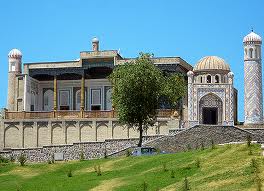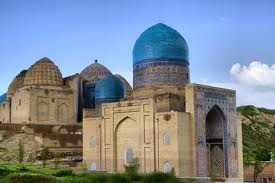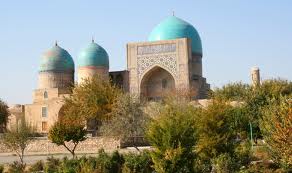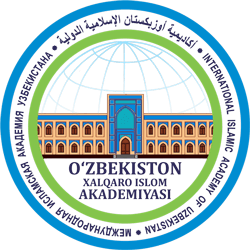Samarkand places of interest
Samarkand.jpg) Samarkand had been known since the middle of the 1st millennium BC., and firstly it was mentioned as Markand in the texts of Avesta, the capital of the rich region Sogd (Sogdiana). Almost completely destroyed by the troops of Alexander the Great, the legendary Sogdian Afrasiab was rebuilt a little away from its original location, and once again became the center of the Ariana province (one of the titles of the city – “Makhfuza” can be translated as “stored”). In the IV century BC. Samarkand was a part of the Selevkids, in the II-I centuries. BC. The Bactrian kingdom was flourishing on these lands, and at the beginning of the new millennium the region fell under the authority of the Kushan Empire. In 712 the Arab forces under the command of Kuteyba ibn -Muslim occupied the city, but within a year the first of the popular uprisings that almost a century shook the north-eastern outskirts of the Caliphate, broke out. And in 809, thanks to these rebellions, Samarkand again got a degree of independence and became the largest city region. March 17, 1220 the army of Genghis Khan marched into Samarkand, and in 1227 after his death the city became the residence of the second son of Genghis Khan – Chagatai. With the advent to power of Amir Timur, the city became the capital (1370) of his vast empire, and entered a period of unprecedented cultural and economic prosperity, continuing in Ulugbek’s time, the grandson of Timur. In the XIV-XV centuries the citadel and city walls were built, wide streets were laid, grandiose architectural ensembles were erected, and on the perimeter the city was surrounded with a giant ring of 13 huge parks and gardens. Most of these objects are still major symbols of the city.
Samarkand had been known since the middle of the 1st millennium BC., and firstly it was mentioned as Markand in the texts of Avesta, the capital of the rich region Sogd (Sogdiana). Almost completely destroyed by the troops of Alexander the Great, the legendary Sogdian Afrasiab was rebuilt a little away from its original location, and once again became the center of the Ariana province (one of the titles of the city – “Makhfuza” can be translated as “stored”). In the IV century BC. Samarkand was a part of the Selevkids, in the II-I centuries. BC. The Bactrian kingdom was flourishing on these lands, and at the beginning of the new millennium the region fell under the authority of the Kushan Empire. In 712 the Arab forces under the command of Kuteyba ibn -Muslim occupied the city, but within a year the first of the popular uprisings that almost a century shook the north-eastern outskirts of the Caliphate, broke out. And in 809, thanks to these rebellions, Samarkand again got a degree of independence and became the largest city region. March 17, 1220 the army of Genghis Khan marched into Samarkand, and in 1227 after his death the city became the residence of the second son of Genghis Khan – Chagatai. With the advent to power of Amir Timur, the city became the capital (1370) of his vast empire, and entered a period of unprecedented cultural and economic prosperity, continuing in Ulugbek’s time, the grandson of Timur. In the XIV-XV centuries the citadel and city walls were built, wide streets were laid, grandiose architectural ensembles were erected, and on the perimeter the city was surrounded with a giant ring of 13 huge parks and gardens. Most of these objects are still major symbols of the city.
 The main attraction of Samarkand is Registan (XV-XVII cc.), it is one of the most beautiful squares in the world, surrounded by a great deal of grand old buildings, minarets and mausoleums, that the square itself seems a giant exhibition hall of the history. The meeting of the sunrise is especially impressive on it, the time when the dark shadows create the most fantastic combinations of shapes and display the most inconspicuous, at first glance, pattern features of the delicate stone carvings of adorning walls and portals of the buildings, which surround the square. You will be amazed by the decoration of Samarkand buildings and monuments. The art of glazed cladding reached its highest point here, there is no any surface area without decoration on many old buildings. And there is no any world architecture, which knows such an unrestrained abundance of multicolored ornamental paintings, gold and glazed revetment, both before and after. Tilla-Kari madrassah (XVII century) is a striking example. It received even the name of “gilt” thanks to the interior of the domed hall, completed by the painting “kundal.” Even famous masters of the Caliphate did not know such a monolithic gilding of so vast surfaces.
The main attraction of Samarkand is Registan (XV-XVII cc.), it is one of the most beautiful squares in the world, surrounded by a great deal of grand old buildings, minarets and mausoleums, that the square itself seems a giant exhibition hall of the history. The meeting of the sunrise is especially impressive on it, the time when the dark shadows create the most fantastic combinations of shapes and display the most inconspicuous, at first glance, pattern features of the delicate stone carvings of adorning walls and portals of the buildings, which surround the square. You will be amazed by the decoration of Samarkand buildings and monuments. The art of glazed cladding reached its highest point here, there is no any surface area without decoration on many old buildings. And there is no any world architecture, which knows such an unrestrained abundance of multicolored ornamental paintings, gold and glazed revetment, both before and after. Tilla-Kari madrassah (XVII century) is a striking example. It received even the name of “gilt” thanks to the interior of the domed hall, completed by the painting “kundal.” Even famous masters of the Caliphate did not know such a monolithic gilding of so vast surfaces.
 Starting the way from Registan, you can bypass the whole old city, having seen such unique monuments of culture, as Ishrat-Khona mausoleum (the women of the Timurid dynasty lie here , XV c.), Observatory of Ulugbek (1428-1429), Rukhabad mausoleum(Rukhobod , the tomb of the Islamic mystic, Burhaneddin Sagaradzhi, XIV century), the Mausoleum of Khoja Abdi-Darun (X-XVII c.), the Mausoleum of Imam al-Bukhari (IX-XIII centuries, recently fully restored) with a magnificent trimming of the dome, and the ( XIV). Ulugbek madrassah (1417-1420 ), Sher-Dor madrassah (1619-1636) and Tilla-Kori madrassah (1646-1647) rise above Registan. In Samarkand the object of worship is a mosque of Timur – Bibi Khanim Mosque (the largest medieval building in Central Asia, 1399-1404). Not far from the Mosque there is the Mausoleum of Timur and his descendants – Gur-Emir (Guri-Amir, 1403-1410), which affects with its perfect proportions and proportionality forms, resembling a giant blue tulip. The panels of its interior walls are made of yellow-green marble, painted in blue and decorated with gold, so that the flickering and air effect of the internal volume of the burial vault arises in the dome space.
Starting the way from Registan, you can bypass the whole old city, having seen such unique monuments of culture, as Ishrat-Khona mausoleum (the women of the Timurid dynasty lie here , XV c.), Observatory of Ulugbek (1428-1429), Rukhabad mausoleum(Rukhobod , the tomb of the Islamic mystic, Burhaneddin Sagaradzhi, XIV century), the Mausoleum of Khoja Abdi-Darun (X-XVII c.), the Mausoleum of Imam al-Bukhari (IX-XIII centuries, recently fully restored) with a magnificent trimming of the dome, and the ( XIV). Ulugbek madrassah (1417-1420 ), Sher-Dor madrassah (1619-1636) and Tilla-Kori madrassah (1646-1647) rise above Registan. In Samarkand the object of worship is a mosque of Timur – Bibi Khanim Mosque (the largest medieval building in Central Asia, 1399-1404). Not far from the Mosque there is the Mausoleum of Timur and his descendants – Gur-Emir (Guri-Amir, 1403-1410), which affects with its perfect proportions and proportionality forms, resembling a giant blue tulip. The panels of its interior walls are made of yellow-green marble, painted in blue and decorated with gold, so that the flickering and air effect of the internal volume of the burial vault arises in the dome space.
 The city Art Museum, Ak-Saray Mausoleum (1470), Namozgokh mosque (XVII century), Khoja Ahror Madrassah (XV century), the Mausoleum of Khoja Abdi Darun (IX century), Chupon Ata mausoleum (1430-1440) and Khazrat-Khizr mosque (Khazrati-Hyzr, XIX century) are also of interest.
The city Art Museum, Ak-Saray Mausoleum (1470), Namozgokh mosque (XVII century), Khoja Ahror Madrassah (XV century), the Mausoleum of Khoja Abdi Darun (IX century), Chupon Ata mausoleum (1430-1440) and Khazrat-Khizr mosque (Khazrati-Hyzr, XIX century) are also of interest.
The settlement Afrasiab (VII-II c. BC.) borders upon the city boundary from the north, In the southern part of Afrasiab a unique ensemble of burial vaults Shokhi Zinda(1370-1449), formed by standing on both sides of the cenotaph (an imaginary grave) of the muslim saint Abbas ibn- Kussam, mosques and mausoleums of the XI-XV centuries, stretched. Afrasiab Museum with an extensive collection of archaeological finds made on the site of this ancient city is located here. You also should visit the city market Chorsu (XVIII century), get to a nearby Urgut with its well-known market and centuries-old plane trees, or visit the cave of Khazrat Daud ( as Muslims call the biblical King David) in the spur of the Turkestan Range, near Aksai village.
